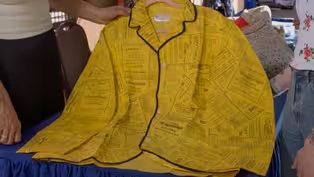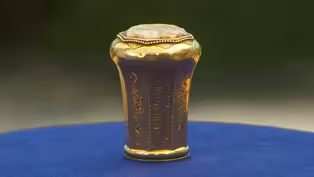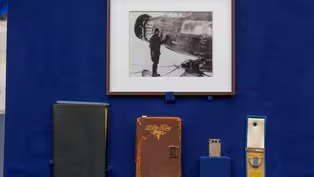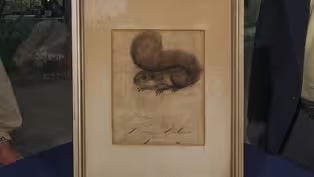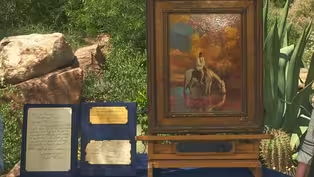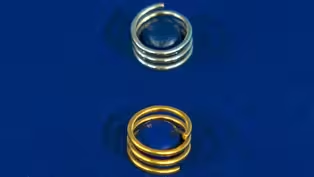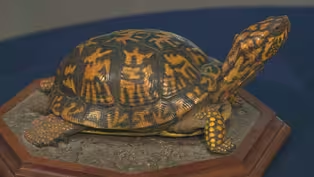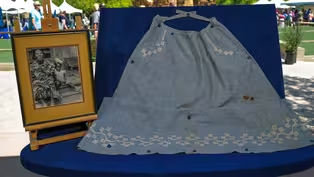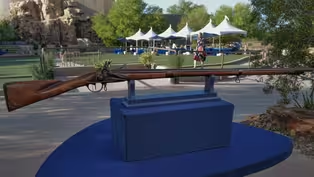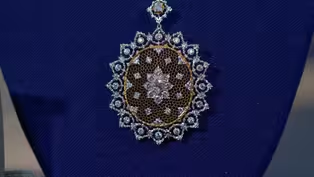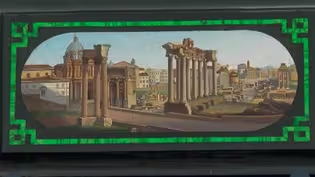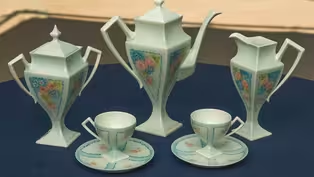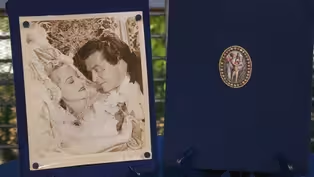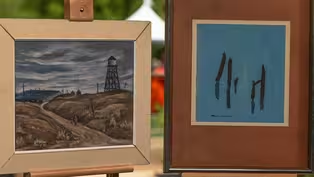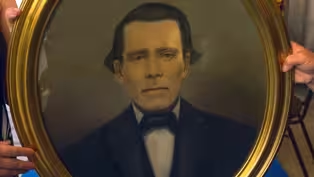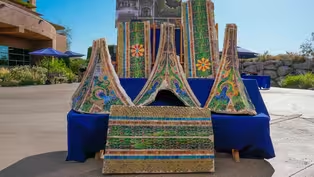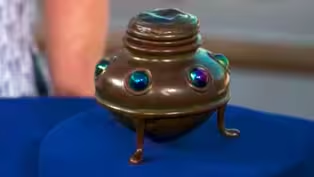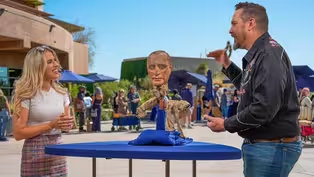
Appraisal: Harry Kellar Illusion Head, ca. 1900
Clip: Season 29 Episode 5 | 3m 53sVideo has Closed Captions
Appraisal: Harry Kellar Illusion Head, ca. 1900
Watch James Supp appraise a Harry Kellar illusion head, ca. 1900, in Springs Preserve, Hour 2.
Problems playing video? | Closed Captioning Feedback
Problems playing video? | Closed Captioning Feedback
Funding for ANTIQUES ROADSHOW is provided by Ancestry and American Cruise Lines. Additional funding is provided by public television viewers.

Appraisal: Harry Kellar Illusion Head, ca. 1900
Clip: Season 29 Episode 5 | 3m 53sVideo has Closed Captions
Watch James Supp appraise a Harry Kellar illusion head, ca. 1900, in Springs Preserve, Hour 2.
Problems playing video? | Closed Captioning Feedback
How to Watch Antiques Roadshow
Antiques Roadshow is available to stream on pbs.org and the free PBS App, available on iPhone, Apple TV, Android TV, Android smartphones, Amazon Fire TV, Amazon Fire Tablet, Roku, Samsung Smart TV, and Vizio.
Buy Now

ANTIQUES ROADSHOW 2025 Tour!
Enter now for a chance to win free tickets to ANTIQUES ROADSHOW's 2025 Tour! Plus, see which cities we're headed to!Providing Support for PBS.org
Learn Moreabout PBS online sponsorshipGUEST: I'm a magician, and I'm really passionate about magic history... APPRAISER: Mmm.
GUEST: ...in addition to Performing and magic technique.
So sometimes, when antiques and magic collide... APPRAISER: Mmm.
GUEST: ...that's really exciting to me.
Found this online, and basically, a antique store in London that didn't specialize in magic... APPRAISER: Mmm.
GUEST: ...but just, like, high-end antiques, they had this head.
They acquired it from an artist who acquired it in New York in about the '60s.
And they bought it with the understanding that it had belonged to Houdini and it was used in illusions.
Based on some research I've done... APPRAISER: Mm-hmm.
GUEST: ...think it's, uh, actually Harry Kellar.
APPRAISER: Mm-hmm.
GUEST: Which is where Harry Houdini got his name, Harry.
APPRAISER: Mm-hmm.
GUEST: Because Harry Kellar was, like, the O.G.... APPRAISER: Mm-hmm.
GUEST: ...magician and, like, an idol to Harry Houdini.
APPRAISER: Yeah.
GUEST: And Harry Kellar had actually gifted Houdini his props and things like that towards the end of his life.
So logistically, that would match up.
APPRAISER: It's made from hardwood.
GUEST: Yeah.
APPRAISER: It's very well-carved.
You look at pictures and posters of Harry Kellar, and there's a pretty astonishing resemblance.
I'm right there with you, I believe it is Harry Kellar.
Harry Kellar is known as the dean of American magicians.
He was born in 1849, and had kind of an odd career beforehand.
Had a couple of false starts as a performer.
And his career really hit it big in the 1880s.
He quickly, over the course of a 40-odd-year career, became one of the most important American magicians, period.
Previously, a lot of magicians relied on vaudevillian sleight of hand, quick stage acts that you could perform anywhere.
He really mastered the art of larger stage shows.
GUEST: Yeah, for sure.
APPRAISER: Uh, performing for, i, in Brazil and South America and all over the world.
And what he did is, he relied more, not so much on sleight of hand, but more of larger illusions and mechanical tricks and devices to help him do his performances.
And in the magic world, those props are custom-made.
GUEST: Yeah.
APPRAISER: They can be unique to the ideas and the techniques that magician uses.
And those secrets are held very, very closely.
They don't often enter the open market.
A lot of these stage illusions, especially, are going to be traded behind the scenes.
With regards to Harry Kellar, he retired in 1908.
He was good friends with Houdini later in life, and, yeah, a lot of his stuff went to Harry Houdini, but this never really shows up anywhere.
I'm not able to find any idea of what kind of trick it was used for.
At a guess, is, my thought, it was probably used for a spiritualism trick of some sort, a levitating head of some sort.
Do you have any idea how you might use it?
GUEST: We kind of think that it could be a spirit-cabinet-type thing... APPRAISER: Mm-hmm.
GUEST: ...where, like, the face will, like, float around... APPRAISER: Mm-hmm.
GUEST: ...and, like, in this ethereal-type... APPRAISER: Mm-hmm.
GUEST: ...ectoplasma or something.
APPRAISER: Another interesting little tidbit about Harry Kellar is that all those props sank, uh, in a shipwreck.
GUEST: Yeah.
APPRAISER: So we know it's probably not from before that period-- it, it's gotta be later.
And this is an older man.
It's probably around 1900 or so.
In that era, a lot of magicians would build their own props, uh, their own illusions.
But this is a very, very skilled carving, and my suspicion is, he probably had it commissioned.
Do you remember what you paid for this?
GUEST: Yeah-- total with shipping and everything... APPRAISER: Mm-hmm.
GUEST: ...from Europe was about $5,000 U.S. APPRAISER: Because of the scarcity of high-end magic props and effects entering the open market, I would not be comfortable putting an auction estimate on it, because we don't know what these trade privately for.
But I would have no problem putting an insurance estimate of $60,000 to $80,000 on it.
GUEST: Oh, yeah... (chuckles) Wow.
Ha!
(laughing) APPRAISER: And I'm sure that there are a few people who would probably pay much more.
But again, it's all a secret.
GUEST: (snorts) Yeah, true.
Yeah, wow.
I've showed it to a few people.
Um, and they're definitely, uh, jelly for sure.
APPRAISER: (laughs) GUEST: But this is kind of my first time really displaying it openly.
APPRAISER: Mm-hmm.
Appraisal: Paper Men's Jacket, ca. 1965
Video has Closed Captions
Clip: S29 Ep5 | 51s | Appraisal: Paper Men's Jacket, ca. 1965 (51s)
Appraisal: 1861 Presentation Gold Letter Seal
Video has Closed Captions
Clip: S29 Ep5 | 1m 55s | Appraisal: 1861 Presentation Gold Letter Seal (1m 55s)
Appraisal: 1928 - 1930 R.E. Byrd Antarctic Expedition Group
Video has Closed Captions
Clip: S29 Ep5 | 3m 17s | Appraisal: 1928 - 1930 R.E. Byrd Antarctic Expedition Group (3m 17s)
Appraisal: 1933 Barney Nelson Crayon Drawing
Video has Closed Captions
Clip: S29 Ep5 | 1m 53s | Appraisal: 1933 Barney Nelson Crayon Drawing (1m 53s)
Appraisal: Bert Phillips Oil Painting, ca. 1935
Video has Closed Captions
Clip: S29 Ep5 | 2m 43s | Appraisal: Bert Phillips Oil Painting, ca. 1935 (2m 43s)
Appraisal: Dinh Van-designed Cartier Gold Ring, ca. 1955
Video has Closed Captions
Clip: S29 Ep5 | 2m 6s | Appraisal: Dinh Van-designed Cartier Gold Ring, ca. 1955 (2m 6s)
Appraisal: Doug Eppes Eastern Box Turtle Carving, ca. 1975
Video has Closed Captions
Clip: S29 Ep5 | 2m 34s | Appraisal: Doug Eppes Eastern Box Turtle Carving, ca. 1975 (2m 34s)
Appraisal: Formerly Enslaved Woman's Apron, ca. 1900
Video has Closed Captions
Clip: S29 Ep5 | 4m 15s | Appraisal: Formerly Enslaved Woman's Apron, ca. 1900 (4m 15s)
Appraisal: French Model 1763/66 Musket, ca. 1770
Video has Closed Captions
Clip: S29 Ep5 | 3m 19s | Appraisal: French Model 1763/66 Musket, ca. 1770 (3m 19s)
Appraisal: Gianmaria Buccellati Diamond & Gold Necklace, ca. 1972
Video has Closed Captions
Clip: S29 Ep5 | 3m 1s | Appraisal: Gianmaria Buccellati Diamond & Gold Necklace, ca. 1972 (3m 1s)
Appraisal: Italian Micromosaic, ca. 1870
Video has Closed Captions
Clip: S29 Ep5 | 2m 24s | Appraisal: Italian Micromosaic, ca. 1870 (2m 24s)
Appraisal: Limoges China-painted Coffee Set, ca. 1925
Video has Closed Captions
Clip: S29 Ep5 | 2m 15s | Appraisal: Limoges China-painted Coffee Set, ca. 1925 (2m 15s)
Appraisal: Paulette Goddard-worn Joseff of Hollywood Brooch
Video has Closed Captions
Clip: S29 Ep5 | 2m 14s | Appraisal: Paulette Goddard-worn Joseff of Hollywood Brooch (2m 14s)
Appraisal: Paul Horiuchi Oil Painting & Collage
Video has Closed Captions
Clip: S29 Ep5 | 3m 58s | Appraisal: Paul Horiuchi Oil Painting & Collage (3m 58s)
Appraisal: Sun Enlargement Photo & Bubble Glass Frame, ca. 1900
Video has Closed Captions
Clip: S29 Ep5 | 1m 3s | Appraisal: Sun Enlargement Photo & Bubble Glass Frame, ca. 1900 (1m 3s)
Appraisal: Tiffany Glass Mosaics, ca. 1915
Video has Closed Captions
Clip: S29 Ep5 | 2m 33s | Appraisal: Tiffany Glass Mosaics, ca. 1915 (2m 33s)
Appraisal: Tiffany Studios Bronze & Glass Inkstand, ca. 1903
Video has Closed Captions
Clip: S29 Ep5 | 1m 48s | Appraisal: Tiffany Studios Bronze & Glass Inkstand, ca. 1903 (1m 48s)
Preview: Springs Preserve, Hour 2
Video has Closed Captions
Preview: S29 Ep5 | 30s | Preview: Springs Preserve, Hour 2 (30s)
Providing Support for PBS.org
Learn Moreabout PBS online sponsorshipSupport for PBS provided by:
Funding for ANTIQUES ROADSHOW is provided by Ancestry and American Cruise Lines. Additional funding is provided by public television viewers.


